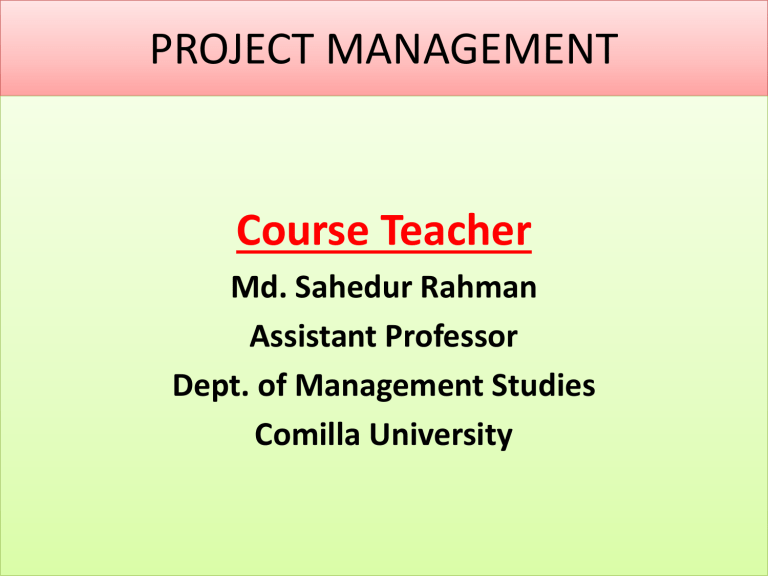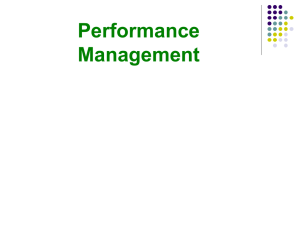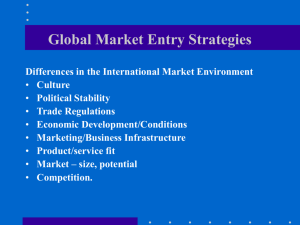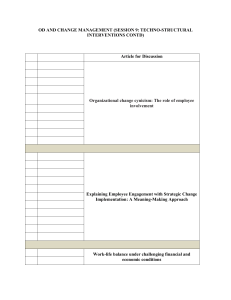
PROJECT MANAGEMENT Course Teacher Md. Sahedur Rahman Assistant Professor Dept. of Management Studies Comilla University Book References: Text Book: 1. “Project Management”- Rajeev M. Gupta 2. “Modern Project Management”- R.C. Mishra CHAPTER-1 INTRODUCTION What is project? • Projects are a group of activities that have to be performed with limited resources to yield specific objectives, in a specific time, and in a specific locality. Thus, a project is a temporary endeavor employed to create a unique product, service or results. Projects are an investment on which resources are used to create assets that will produce benefits over an expanded period of time. • It is a unique process, consisting of a set of coordinated and controlled activities with start and finish dates, undertaken to achieve an objective conforming to specific requirements, including the constraints of time, cost and resources. Contd…. • Project Management Institute of USA has good definition for it. “A project, according to the institute, is a one-shot, time-limited, goal directed, major undertaking, requiring the commitment of varied skills and resources.” • According to Harison, A project can be defined as a non-routine, non-repetive, one-off undertaking, normally with discrete time, financial and technical performance goals. Contd… • Examples of a project:The development and introduction of a new services. The development of a management information system. The introduction of an improvement to an existing process. Setting up a new care initiative. The production of a new customer newsletter, catalogue or Web site. Program Vs. Project Program Project Program Managers create high-level plans used to provide Project Managers perform detailed planning to manage guidance to projects. Detailed plans are created from this delivery of the products of the Project guidance by the Project Managers . Program success is measured in terms of business benefit, Project success is measured in terms of budget, time, and ROI, or new capabilities scope delivered Focus is on leadership, as Program Managers manage Focus is on management of the people (specialists and managers. Program Managers need to facilitate and technicians) involved to deliver manage political aspects, relationships, and conflict resolution. Program Managers manage managers Project Managers manage technical people Programs have a wide scope, focusing on benefits, and Projects have a narrow scope, focusing on deliverables may have to change scope dramatically during their execution to meet the changing needs of the organization Program managers monitor and control projects Project Managers monitor and control tasks Programs are typically executed over a much longer Projects are typically of a shorter duration than programs, timescale than projects, often several years often just a few weeks Why Projects are initiated? Projects are initiated in the following scenarios: 1. 2. 3. 4. 5. 6. 7. 8. When starting a new business. In order to develop/ modify a product or service. For relocating and/or closing a facility. For regulatory mandate. For some community issues. In order to re-engineer the process so as to reduce complaints, reduce cycle time, and eliminate errors. For implementing a new system or process. To introduce new equipment, tools or techniques Features of Project 1. Specific purpose (s): Every project is purpose oriented. It is never possible to form a project without specific purpose (s). When multi-purposes can be satisfied through project, it is called multi-purpose project. 2. Specific direction: Projects act as an organization, having same structure in which top, middle & lower level management are involve to direct corresponding level of management that means top management give direction to middle level management and middle level to lower level management to achieve project goal. 3. Definite life cycle: A project has a life cycle reflected by idea generation planning, and execution stages. – Idea generation stage: In this stage, idea generator must generate idea about project alike why projects need, what types of projects need etc. – Planning stage: In this stage, idea generator must make a plan that is deciding in advance what is to be done. – Execution stage: In this stage, how will executive the project is deciding. Contd… 4. Complex interdependency: Project is a temporary organization. Every project works as a helping hand of organization and every project have its parent organization. A project runs through organizational environment. Organizational environment can be two types. – Internal environment: Internal environment consists of those who are participating in idea generator stage. – External environment: External environment consists of those who are influenced the project. Every disciplinary people suffer ego problem and comes from different discipline. So project director has to realize their differences to execute the project smoothly. 5. Uniqueness: Projects must have the feature of uniqueness. Two projects are not exactly similar even if the plans are exactly or merely duplicated. Sometime projects may look like similar but in really they are different. So project must not be same. Contd… 6. Conflicting environment: As projects act as an organization, so conflict may arise from different level of management. But here conflict means different strategies not creating violence. Because variety of people are gathered with different interest in a project. So management should be know about project clearly and then should reform it. 7. Neutral Judgment: Project manager should judge every employee’s task impartially. That’s why every one can enjoy inspiration to work. 8. Non-repetitive: Projects must not be repeated again and again. One project must be ended, when its goal will be achieved. 9. Risk and uncertainty: Every project has risk and uncertainty associated with it. The degree of risk and uncertainty depend on now a project has passed through its various life-cycle phases. An ill-defined project will have extremely high degree of risk and uncertainty. Classification of Project On the basis of national income and socio-economic activities: on the basis of national income and socio-economic activities project can be classify on different categories• Industrial project: establishment of new industry, introducing new wings of established industry, innovation of new product are categorized in industrial project. • Agricultural project: Invention of High Yielding verities of seeds, research for enhancing yielding capacities of seeds, introduction of technology based production system in agriculture are examples of agricultural project. • Education project: program for enhancing quality and rate of education, compulsory primary education, and adult education are termed as educational project. • Engineering project: Innovation of new technology, program for developing infrastructure facilities are examples of engineering project. Contd… On the basis of production-materials: On the basis of production materials project can be classified into two categories• Capital intensive project: Capital intensive project requires huge investment as well as modern technology. This is especial feature of project of developed countries. • Labor intensive project: Labor intensive project employs large number of people. This is a distinguishing feature of project of developing country like Bangladesh. Contd… On the basis of partnership: Project partnerships represent collaborative partnerships between different countries. On the basis of partnership of project, project can be classified into two groups• Single owned project: single owned project is characterized by internal source of finance and often use of indigenous technology. • Partnership project: Partnership project is characterized by internal and external sources of finance and use of technology granted form foreign countries or international organizations. Contd… Government identifies and selects different types of project for the socio-economic development of a country. Above mentioned different projects than classified as per different determinates. These are discussed in below Determinat-01 Project Outcomes: On the basis of project’s inflows, project can be classified into three categories• X Type Project: Productive and revenue earning project is called X type project. This types of project is self-financing in nature, produce and distribute commodities for earn revenue.Different types of industrial project are termed as X type project. • Y Type Project: Productive but not revenue generating is called Y type project. This type of project generates facilities for other project so that they can earn revenue. For example irrigation project. • Z Type Project: Project who renders service is called Z type project. Outcomes of this project generally non measurable. Education, training, hospital, road, bridge, culvert, weather forecasting examples of Z type project. Contd… Determinant-02 Preference on allocation of resources: On the basis of national urgency and importance, project can be classified into two categories. • Core project: Project which is selected for priority basis on the basis of national importance and socio-economic development is called core project. Core project includes– Approved project, revised and non approved project and project nominated by project evaluation committee. – Projects whose have available internal and foreign inflow of fund. – Partially completed project. – X type and Z type project. • Non-core project: Other than core project. Contd… Determinant-03 Stage of project: On the basis of project formulation and implementation, project can be classified into four categories• Experimental project: A trial or special observation, examine is made to confirm or disprove something doubtful; esp., one under conditions determined by the experimenter; called experimental project. This type of project is conducted in narrow environment. • Pilot Project: The next step of experimental project is pilot project. Pilot is wider than experimental project so it requires more allocation of fund. Acceptability, applicability and utility of experimental results are main considerations of pilot project. • Demonstration Project: Demonstration Projects designed to prove the viability of new technologies offering potential economic advantage but which cannot be commercialized directly. Demonstrated project is initiated after successful completion of pilot project. Project cycle of Warran C. Baum . 1. Project identification 2. Project preparation 6. Project evaluation 3. Project appraisal 5. Project implementation and supervision 4. Project negotiation Figure: Project Cycle Contd… 1. Project identification: According to Baum project identification is the first stage of project cycle. Through project identification essential Matters are identified and conceptions built. Profit oriented investment possibility is created through project identification and that possibility is achieved by existing development activities of a country. 2. Project preparation: Project preparation means preparation of project design in all volume o financial, finance, social, institutional. One of the stags of project preparation is to conduct feasibility study. 3. Project Appraisal: It is a process of decision making for selecting a project by which it is possible to ensure maximum utilization of minimum resources. The purposes of this stage are the determination of projects commercial gain, economic effectiveness and social acceptability. Contd… 4. Project Negotiation: In respect of aid oriented project through negotiation aid provider and aid receiver reach in consent to take proper steps for the success of the project. Subsequently such consent turns into legal obligation that is disclosed in debt deed. 5. Project implementation and supervision: Project implementation stage includes construction to project structure. Steady political commitment easy design, proper project preparation and meaningful management etc. are required for successful implementation of project. 6. Project evaluation: Project evaluation is called the last stage and in many cases it is called post project complementation observation project evaluation is done to analyze and judge the outcome that has achieved in compassion to the project’s goal. Its effectiveness is not only applicable to the completed project but also equally effective for the running project What is Project Management? • Project Management is the discipline of organizing and managing resources in such a way that these resources deliver all the work required to complete a project within defined scope, time, and cost constraints. It is important to note here that a project is a temporary and one-time endeavor undertaken to create a unique product or service that brings about beneficial change or added value. • Management in any project is concerned with productivity. This refers to efficiency and effectiveness. These can be explained as follows: • Efficiency: In order to be efficient, management is concerned with minimizing resource costs. Efficiency is “doing things right”. • Effectiveness: In order to be effective, management is concerned with getting activities completed. Effectiveness is “doing right things”. Contd… • According to Chase and Aquilano “Project management can be defined as the planning, directing and controlling of resources (People, equipment, material) to meet the technical, cost and time constraints of the project. • According to B.B. Goel “Project management is an organized venture or managing projects that involves scientific application of modern tools and techniques in Planning, financing, implementing, Monitoring, controlling and Coordinating unique activities of tasks to produce desirable outputs in consonance with predetermined objectives within the constraints of time, cost, quantity and quality.” Objectives of project management 1. Ensure projects are delivered with budget 2. Ensure projects are delivered with schedule 3. Deliver quality solutions: reduced errors, improved effectiveness, appropriate risk management and internal control 4. Continuous process improvement via collaboration 5. Implement project communication and oversight Elements of project management • 1. Operations: Operation means activities those are performed to conduct the project. So it includes all the activities in a project. • 2. Resources: Resources mean men, machines, materials, technologies and time those are used to complete the project. So, the elements which are used to accomplish the project are called resources. • 3. Condition: The surroundings and the barriers of the project in which the project is performed are known as condition. So, condition affects the effectiveness of the project activities. Functions of project management Project Manager . Planning Terminating the project Coordinating Maintaining Linkage Staffing and Training Conflict Management Implementing Change Management Controlling & Reporting Project Financial Management Contd… 1. 2. 3. 4. 5. 6. 7. To execute of proper planning of project function based on project objectives. To make budget and work list by using modern techniques based on planning of project Selection of employees for project and give training, and determine the relation and leadership role. Supervision and control of activities of project as per predetermined time, cost and standard. Maintain link with parent organization and its different division. Maintain relation among competitive organization government and non-government organization and other related parties. Make evaluation report after project is executed. Importance of project Management • Rapidly changing technologies: Technologies are changing very fast, so all manufacturing as well as service organizations have to cope up with technological changes, which provide a big scope for project management. • High entropy of the system: Changes are very fast. So, energy level are high. To adapt to the fast changing world, no organization can stick to old things or systems. Any modification or moderation leads to the need of projects. Contd… Squeezed life cycle of products: Product life cycle is squeezed to a great extent with innovations taking place at a very rapid rate. Projects are needed for the up gradation of products. Globalization impact: All producers and service providers in the present world are exposed globally. They need to modify their system of operations to match the global practices, thus creating opportunity for projects Contd… Large organizations: They face problems of management of huge workforce and work division. So they divide their work in projects and create a team to accomplish the objectives in the form of projects. Customer focus: Increased customer focus has been a market trend in recent time, a few years back, cost reduction was a major formula of success for an organization. Who is a Project Manager? • A project manager is a professional in the field of project management. They have the responsibility of the planning and execution of any project. A project manager's central duty is to ensure the success of a project by minimizing risk throughout the lifetime of the project. This is done through a variety of methods, both formal and informal. A project manager usually has to ask penetrating questions, detect unstated assumptions, and resolve interpersonal conflicts, as well as use more systematic management skills. Activities of Project Managers 1. Traditional management: This includes decision making, planning, and controlling 2. Communication: This refers to exchanging routine information and processing paperwork. 3. Human Resource Management (HRM): It involves motivating, disciplining, managing conflict, staffing, and training. 4. Networking: It includes socializing, and interacting with outsiders. An average manager spends: • 32% of time in traditional management activities • 29% in communicating • 20% in HRM activities • 19% in networking Skills of project manager • Technical Skill is the knowledge of and proficiency in activities involving methods, processes, and procedures. • Human Skill is the ability to work with people; cooperative effort; it is teamwork; feel secure and free to express their opinions. • Conceptual Skill is the ability to see “big picture” in order to recognize significant elements in a situation, and to understand relationships among elements. • Design Skill is the ability to solve problems in ways that will benefit enterprise. Critical factors to a project success 1. 2. 3. 4. 5. 6. 7. 8. 9. Project mission Top management support Project plan Client consultation and acceptance Personnel Technical tasks Monitoring and feedback Communication and troubleshooting THANK YOU




